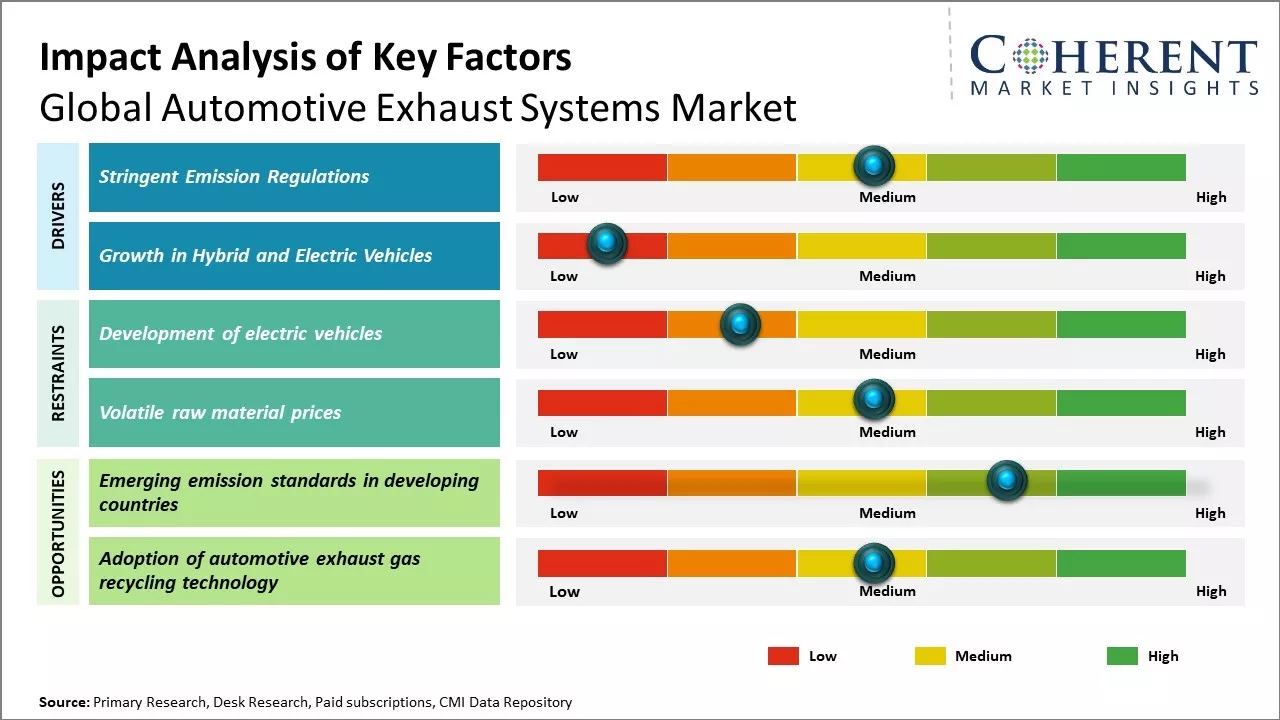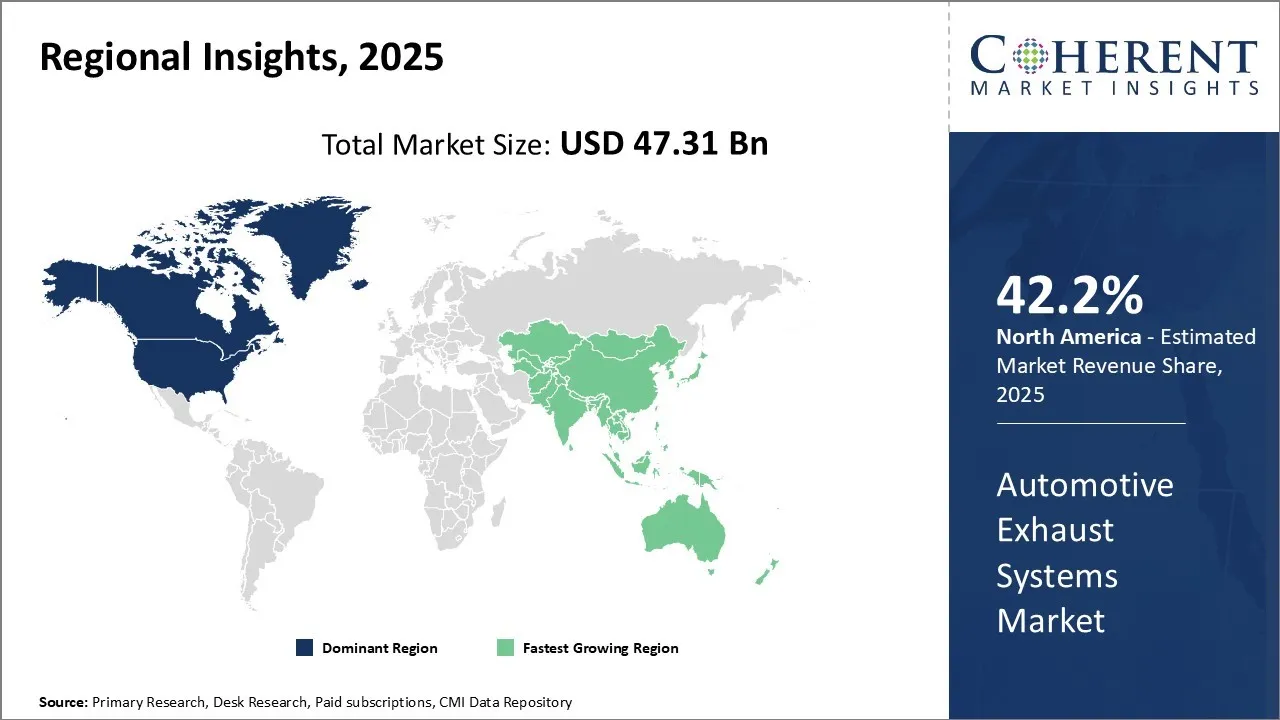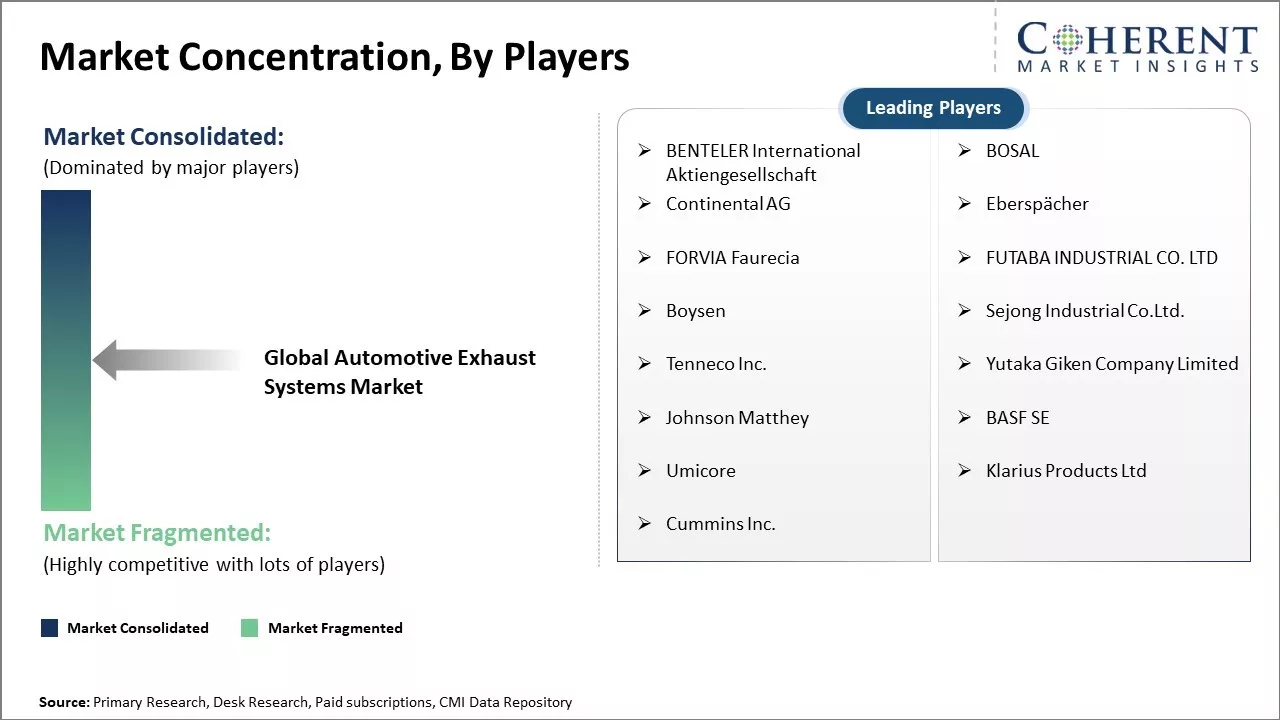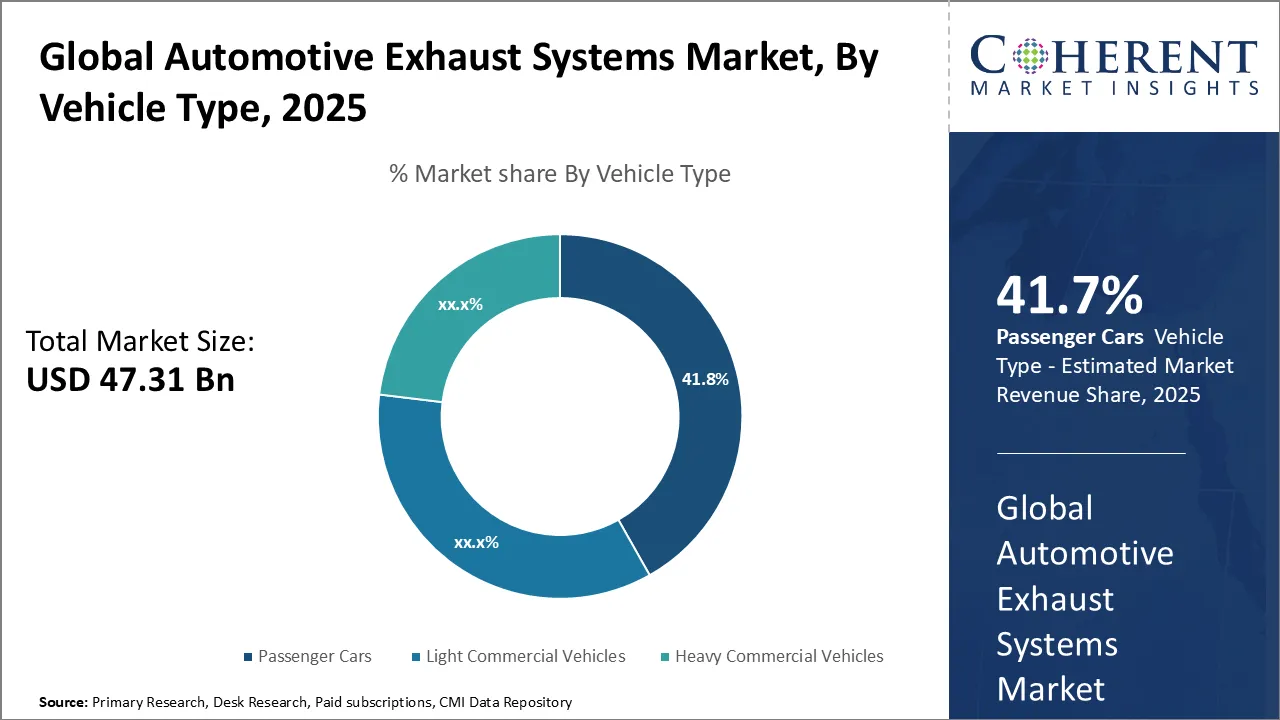Automotive Exhaust Systems Market Size and Forecast – 2025 to 2032
The Global Automotive Exhaust Systems Market is estimated to be valued at USD 47.31 Bn in 2025 and is expected to reach USD 77.02 Bn by 2032, exhibiting a compound annual growth rate (CAGR) of 7.2% from 2025 to 2032.

To learn more about this report, Download Free Sample
Key Takeaways
- Based on Component, the Exhaust pipes segment leads the market holding the largest share in 2025, as it is widely used across all vehicle types, and face frequent replacement, driving the largest demand.
- Based on Fuel Type, the Gasoline segment is projected to account for 39.2% of the market share in 2025, owing to its relatively lower emissions compared to diesel.
- Based on vehicle Type, the Passenger Cars segment is expected to capture 41.7% share in 2025, owing to rising consumer inclination towards personal mobility solutions.
- Based on Region, North America is expected to lead the market, holding a share of 42.2% in 2025. While, Asia Pacific is expected to be the fastest growing region.
Market Overview
The automotive exhaust systems market is expected to witness positive growth over the forecast period. The growing demand for high-performance vehicles with enhanced functionalities is expected to drive the demand for advanced automotive exhaust systems. Additionally, the strict emission norms implemented by regulatory bodies across countries to reduce the environmental impact is further expected to promote the adoption of efficient exhaust systems. Manufacturers are focusing on developing innovative exhaust technologies such as enhanced catalytic converters that can effectively lower harmful emissions. The rising purchasing power and growing preference for comfortable driving experience are also projected to support the revenue generation in the global automotive exhaust systems market during the forecast period.
Current Events and Its Impact
|
Current Event |
Description and its Impact |
|
Global Electric Vehicle Transition and Automotive Electrification |
|
|
Stringent Global Emission Standards Implementation |
|
Uncover macros and micros vetted on 75+ parameters: Get instant access to report
End-User Needs & Unmet Gaps in the Automotive Exhaust Systems Market
- Growing requirement for cost-effective, durable exhaust systems
- Automotive OEMs and fleet operators seek exhaust solutions that offer high durability and longer replacement cycles at competitive costs. With rising raw material prices and tightening emission regulations, end users increasingly demand products that balance performance, compliance, and affordability without significantly adding to the overall vehicle cost.
- Need for modular designs compatible with new-generation vehicles
- As hybrid and advanced ICE vehicles dominate the transition phase before EV adoption, there is a strong need for modular exhaust systems. End users prefer adaptable designs that can be integrated into different vehicle platforms while meeting evolving emission standards. Such flexibility reduces redesign costs and accelerates adoption among manufacturers.
Automotive Exhaust Systems Market Insights, By Vehicle Type - Passenger Cars is Dominating Due To Rising Consumer Inclination
In terms of vehicle type, passenger cars segment is expected to contribute 41.7% share of the market owing to rising consumer inclination towards personal mobility solutions. Passenger vehicles provide drivers with the convenience of door-to-door transportation of people without reliance on public transit systems. Rapid urbanization and expanding road networks have augmented the demand for private car ownership across major economies. Moreover, original equipment manufacturers emphasize product innovations and aesthetic designs catered towards passenger comfort needs. Luxury and premium features such as advanced infotainment, enhanced interiors, and customizable exhaust notes are particularly appealing to individual drivers. This is further proliferating the automotive exhaust systems market share.
For instance, in September 2024, BorgWarner unveiled its largest twin turbochargers for passenger cars, designed to power General Motors’ new Corvette ZR1 with a 5.5-litre V8, delivering 1,064 hp and 828 lb-ft torque. Integrated exhaust manifolds with equal-length runners enhance performance and refine exhaust noise.
Automotive Exhaust Systems Market Insights, By Component - Exhaust pipes is Demanding Due to It Is Widely Used Across All Vehicle Types
In terms of component, the exhaust pipes segment is expected to contribute the largest automotive exhaust systems market share in 2025. Exhaust pipes are integral components of a vehicle’s exhaust system, responsible for channeling gases from the engine to the tailpipe. They are used across passenger cars, light commercial vehicles, and heavy commercial vehicles. Due to exposure to high temperatures, corrosive gases, and road conditions, exhaust pipes experience wear and tear, leading to frequent replacements. This continuous replacement cycle, combined with rising vehicle production and stringent emission standards, fuels strong demand for exhaust pipes globally. Their critical role in maintaining vehicle performance and compliance with environmental regulations further reinforces their dominance in the market.
For instance, in March 2025, Bugatti unveiled the Tourbillon Équipe Pur Sang, a bespoke hypercar package that redefines luxury and performance. Priced at $240,000, it features a striking eight-pipe exhaust system, a custom front splitter, rear diffuser, and a rear wing designed for enhanced aerodynamics. The package also includes unique 20-inch front and 21-inch rear wheels, and exclusive interior details like embroidered headrests and Alcantara upholstery.
Automotive Exhaust Systems Market Insights, By Fuel Type - Gasoline is Leading Owing to Lower Emission
In terms of fuel type, gasoline is expected to contribute 39.2% share of the market owing to its relatively lower emissions compared to diesel. Despite diesel powertrains witnessing increased popularity in recent years, gasoline engines remain the more environment-friendly alternatives in light of ongoing pollution concerns. With regulatory bodies tightening carbon dioxide and particulate matter standards, automakers continue shifting focus towards gasoline-powered vehicles. Additionally, widespread availability of gasoline fueling infrastructure as well as competitive pricing has boosted consumer preference for gasoline cars over other fuel types. Advanced technologies like direct injection and turbocharging are also enhancing the efficiency and performance of new-generation gasoline engines. Such developments offer automakers and consumers an attractive proposition for reducing automotive emissions.
For instance, in August 2024, Rheinmetall secured a new order valued in the low three-digit million euro range for the supply of exhaust gas recirculation (EGR) valves to a prominent commercial vehicle manufacturer. Production is set to commence in January 2026 and continue through December 2031, with spare parts provision extending 15 years beyond production. The customized EGR valves are designed to enhance emission control by reducing nitrogen oxide emissions by up to 70%, thereby supporting compliance with stringent environmental standards.
Regional Insights

To learn more about this report, Download Free Sample
North America Automotive Exhaust Systems Market Analysis & Trends
North America has established itself as the dominant region in the global automotive exhaust systems market demand. The region is expected to account for 42.2% of the market share. With the U.S. being the largest passenger as well as commercial vehicle producer, the demand for exhaust systems is consistently high. Strong presence of leading OEMs such as General Motors, Ford, and FCA provides a huge base for local exhaust system manufacturers to cater to replacement and aftermarket demand.
Stringent emission norms implemented by the Environmental Protection Agency (EPA) have forced automakers to invest heavily in R&D to develop efficient exhaust technologies. This has benefited the region's exhaust system suppliers who have evolved into global leaders by offering innovative solutions. For instance, major players like Faurecia and Tenneco have established R&D centers and manufacturing plants catering to North American OEMs as well as markets in other regions. Along with significant manufacturing investments, the suppliers have also customized their portfolios based on engine types, fuel type, and vehicle architecture popular in the American automotive exhaust systems market. This has enabled them to effectively address the replacement needs.
For instance, in May 2025, Tata AutoComp Systems Ltd. and Katcon Global have established a joint venture to produce advanced composite materials for the North American market. The venture aims to deliver lightweight components for passenger and commercial vehicles, agricultural tractors, off-road vehicles, and non-automotive applications. This collaboration builds upon a 13-year partnership between the two companies in India, focusing on exhaust systems and emission after-treatment solutions.
Asia Pacific Automotive Exhaust Systems Market Analysis & Trends
The Asia Pacific region has emerged as the fastest growing market for automotive exhaust systems. Factors such as increasing vehicle parc, rising disposable incomes, and growth in commercial vehicle sales are fueling the demand. China, with the world's largest vehicle production, is leading this growth with OEMs steadily enhancing local value addition. Besides, other Southeast Asian countries are also witnessing a boom in the number of passenger cars and two-wheelers.
The thriving aftermarket in the region provides sustained opportunities for both international as well as domestic exhaust suppliers. However, to establish themselves and gain market share in this price sensitive environment, suppliers must offer competitive pricing along with adherence to quality and emission norms. Overall, Asia Pacific’s attractiveness continues to rise due to its massive scale and potential for future increases in automotive demand.
For instance, in August 2025, Purem AAPICO, a joint venture between Purem by Eberspaecher and AAPICO Hitech, has inaugurated two new plants in Malaysia and Thailand to manufacture clean automotive exhaust systems. The Malaysian facility in Rawang spans 4,000 sq. meters with 100 employees, while the Thai plant in Rayong covers 3,000 sq. meters with 150 staff. Both aims to meet rising ASEAN demand for sustainable exhaust solutions.
Automotive Exhaust Systems Market Outlook Country-Wise
The U.S. Automotive Exhaust Systems Market Trends
The United States represents one of the leading markets in the Automotive Exhaust Systems Market in 2025, driven by its strong automotive manufacturing base and high vehicle ownership rates. Stringent emission regulations enforced by agencies such as the EPA push automakers to adopt advanced exhaust after-treatment systems. Additionally, frequent replacement demand due to aging vehicle fleets further fuels consistent market growth.
For instance, in August 2025, Dodge secured a new patent for its Fratzonic Chambered Exhaust, designed to replicate the roar of traditional muscle cars in electric vehicles. The innovation uses chambers and valves to generate a dynamic exhaust-like sound, preserving brand identity while adapting to the EV era. This move underscores Dodge’s commitment to blending heritage with modern performance.
India Automotive Exhaust Systems Market Trends
India is witnessing significant growth in its automotive sector, driven by an expanding fleet of passenger and commercial vehicles. Rising awareness of vehicle emissions and stricter government regulations are pushing both manufacturers and consumers to prioritize exhaust system quality and replacement. This trend, combined with growing road infrastructure and vehicle ownership, fuels the demand for reliable and advanced automotive exhaust systems across the country.
For instance, in June 2025, Sharda Motor Industries Limited commenced commercial production at its new manufacturing facility in Chakan, Maharashtra. The plant, which received its Factory License from the Directorate of Industrial Safety and Health, Government of Maharashtra, will focus on producing exhaust systems, catalytic converters, and other automotive components.
Market Report Scope
Automotive Exhaust Systems Market Report Coverage
| Report Coverage | Details | ||
|---|---|---|---|
| Base Year: | 2024 | Market Size in 2025: | USD 47.31 Bn |
| Historical Data for: | 2020 To 2024 | Forecast Period: | 2025 To 2032 |
| Forecast Period 2025 to 2032 CAGR: | 7.2% | 2032 Value Projection: | USD 77.02 Bn |
| Geographies covered: |
|
||
| Segments covered: |
|
||
| Companies covered: |
BENTELER International Aktiengesellschaft, BOSAL, Continental AG, Eberspächer, FORVIA Faurecia, FUTABA INDUSTRIAL CO. LTD, Boysen, Sejong Industrial Co.Ltd., Tenneco Inc., Yutaka Giken Company Limited, Johnson Matthey, BASF SE, Umicore, Klarius Products Ltd, and Cummins Inc. |
||
| Growth Drivers: |
|
||
| Restraints & Challenges: |
|
||
Uncover macros and micros vetted on 75+ parameters: Get instant access to report
Automotive Exhaust Systems Market Drivers
Stringent Emission Regulations
The automotive industry has witnessed major changes in the past decade due to the stringent emission regulations imposed by governments and regulatory bodies across the world. Emission norms have become more and more stringent with each passing year in order to control air pollution and reduce the impact of greenhouse gas emissions from vehicles. Automakers are under immense pressure to comply with these emission norms and continually reduce the level of harmful exhaust emitted from vehicles. This has significantly boosted the demand for advanced automotive exhaust systems equipped with sophisticated after-treatment devices.
Stringent emission norms such as Euro 6, Bharat Stage VI in India, and China 6 have compelled automakers to overhaul their exhaust system designs. Advanced emission control technologies such as catalytic converters, diesel particulate filters, and selective catalytic reduction systems have become much more complex to treat multiple pollutants simultaneously. This has translated into increased adoption of high-tech exhaust system components including close-coupled and under-body catalytic converters, particulate matter sensors and EN15191 compliant exhaust gas temperature sensors.
For instance, in July 2023, Proton AG, a Swiss company that specializes in privacy and security solutions and AAPICO Hitech Public Company Limited, a Thai automotive components supplier that primarily focuses on the manufacturing of stamped parts, forgings, machined parts, and plastic parts for automotive OEMs, formed a strategic partnership through a joint venture, Purem Aapico, which aims to supply exhaust emission control systems to Proton AG and other vehicle manufacturers in Thailand and the ASEAN automotive exhaust systems market.
Growth in Hybrid and Electric Vehicles
The rising environmental concerns and push for lower carbon mobility has accelerated the growth of hybrid electric vehicles and battery electric vehicles in the past few years. Although the share of hybrid electric vehicle (HEV) and electric vehicle (EVs) is still low in the overall passenger vehicle sales, their adoption rate is increasing steadily supported by government incentives and subsidies.
Unlike conventional internal combustion engine vehicles, hybrid, and electric vehicles do not require traditional bulky exhaust systems. However, they still need smaller customized exhaust components to direct the harmful gases from small Internal Combustion Engine (ICE) range-extenders and treat emissions conforming to stringent norms. This presents automotive exhaust system manufacturers with an opportunity to develop new innovative lightweight exhaust modules optimized for hybrid and electric architectures. It is also spurring continuous technology upgrade to produce exhaust parts with improved heat resistance, corrosion protection, and compact designs.
Market Concentration and Competitive Landscape

To learn more about this report, Download Free Sample
Analyst Opinion (Expert Opinion)
The automotive exhaust systems market value is undergoing a significant transformation, driven by technological advancements, stringent emission regulations, and shifting consumer preferences. While the market continues to expand, certain trends and challenges are reshaping its landscape.
The increasing adoption of advanced exhaust technologies, such as Selective Catalytic Reduction (SCR) systems, Gasoline Particulate Filters (GPF), and Exhaust Gas Recirculation (EGR) systems, is a direct response to tightening emission standards. These innovations are essential for automakers to comply with global regulations and meet consumer demand for cleaner vehicles. For instance, the development of integrated thermal management systems by companies like Tenneco reflects the industry's commitment to enhancing exhaust system performance and efficiency.
The Asia Pacific region, particularly China, plays a pivotal role in the global automotive exhaust systems market. In 2024, China accounted for a substantial automotive exhaust systems market revenue share, driven by its robust automotive production and export activities. Conversely, in Europe, the transition towards EVs is accelerating, leading to a decline in demand for traditional exhaust components. This shift is evident in the significant job losses among European car parts suppliers, as reported in 2024.
Automotive Exhaust Systems Industry News
- In November 2024, Aftermarket specialist B2 Fabrication unveiled a premium exhaust system for the 2015-2024 Ford F-150 models, engineered for both 5.0L and EcoBoost engines. Constructed from high-grade stainless steel, the cat-back exhaust system offers three different sound levels, improved airflow, and bolted-on installation without welding.
- In October 2024, Akrapovič launched Evolution Line (Titanium) exhaust systems for the Porsche Cayenne (536.2) lineup, made from high-grade lightweight titanium. The exhaust includes a central muffler that branches into eye-catching double round carbon-fibre tailpipes. Fully ECE type-approved, it enhances performance with extra power and torque across the rev range.
- In July 2023, a U.K.-based company, Milltek Sport, a leading global manufacturer, introduced an enhanced high-performance exhaust system for BMW's new M2 Coupé, unlocking additional potential from the advanced vehicle. This move reflects the company's ongoing expansion into various vehicle types, further solidifying its position in the performance automotive industry.
Market Segmentation
- Component Insights (Revenue, US$ Bn, 2025 - 2032)
- Manifold
- Exhaust Pipes
- Muffler
- Connector
- Oxygen Sensor
- Fuel Type Insights (Revenue, US$ Bn, 2025 - 2032)
- Gasoline
- Diesel
- Alternate Fuels
- Vehicle Type Insights (Revenue, US$ Bn, 2025 - 2032)
- Passenger Cars
- Light Commercial Vehicle
- Heavy Commercial Vehicle
- Regional Insights (Revenue, US$ Bn, 2025 - 2032)
- North America
- U.S.
- Canada
- Latin America
- Brazil
- Argentina
- Mexico
- Rest of Latin America
- Europe
- Germany
- U.K.
- Spain
- France
- Italy
- Russia
- Rest of Europe
- Asia Pacific
- China
- India
- Japan
- Australia
- South Korea
- ASEAN
- Rest of Asia Pacific
- Middle East & Africa
- GCC Countries
- Israel
- South Africa
- Rest of Middle East & Africa
- Key Players Insights
- BENTELER International Aktiengesellschaft
- BOSAL
- Continental AG
- Eberspächer
- FORVIA Faurecia
- FUTABA INDUSTRIAL CO. LTD
- Boysen
- Sejong Industrial Co.Ltd.
- Tenneco Inc.
- Yutaka Giken Company Limited
- Johnson Matthey
- BASF SE
- Umicore
- Klarius Products Ltd
- Cummins Inc.
Sources
Primary Research
Interviews from the following stakeholders
Stakeholders
- Interviews with exhaust system manufacturers, automotive OEMs, Tier-1 component suppliers, emission control solution providers, fleet operators, and aftersales service heads across leading global markets.
Specific stakeholders
- R&D and product engineers at automotive OEMs (e.g., Toyota, Ford, Volkswagen, Tata Motors)
- Procurement and sourcing managers at Tier-1 suppliers (e.g., mufflers, catalytic converters, sensors)
- Plant and operations managers at exhaust system manufacturing units in Asia, Europe, and North America
- Emission compliance officers at regulatory bodies (e.g., EPA, European Commission Transport & Environment Directorate)
- Fleet and maintenance managers at logistics firms (e.g., DHL, FedEx, DB Schenker)
- Vehicle inspection and testing facility managers in key automotive hubs (e.g., Germany, Japan, India, U.S.)
- Aftermarket distributors and dealers of exhaust and emission components
Databases
- World Trade Organization (WTO) Trade Statistics
- UN Comtrade Database
- U.S. Environmental Protection Agency (EPA) Vehicle & Emission Database
- European Environment Agency (EEA) Transport Emission Statistics
- Eurostat – Automotive Parts Trade & Industry Data
- China Customs Statistics
- Japan Automobile Manufacturers Association (JAMA) Data Portal
- Korea Customs Service Automotive Exports/Imports Data
- Directorate General of Commercial Intelligence and Statistics (DGCIS), India
Magazines
- Automotive World
- Automotive News
- Auto Components India
- Engine + Powertrain Technology International
- Car and Driver (Technology Section)
- WardsAuto
- Automotive Engineering International (SAE)
- The Car Expert (Emission & Regulations section)
Journals
- SAE International Journal of Engines
- International Journal of Automotive Technology
- Journal of Automobile Engineering (IMechE)
- Clean Technologies and Environmental Policy (Springer)
- Applied Thermal Engineering (Elsevier)
- International Journal of Engine Research
- Energy Reports – Automotive & Transportation Section
Newspapers
- The Wall Street Journal – Automotive & Industry
- The Economic Times – Auto & Transport
- The Hindu Business Line – Auto Components
- Financial Times – Mobility & Clean Energy Reports
- Nikkei Asia – Automotive & Supply Chain
- South China Morning Post – Transport & Manufacturing
- Automotive Daily News (Europe/US editions)
Associations
- Society of Automotive Engineers (SAE International)
- European Automobile Manufacturers’ Association (ACEA)
- Automotive Component Manufacturers Association of India (ACMA)
- Japan Automobile Manufacturers Association (JAMA)
- Korea Automobile Manufacturers Association (KAMA)
- China Association of Automobile Manufacturers (CAAM)
- International Council on Clean Transportation (ICCT)
- American Automotive Policy Council (AAPC)
Public Domain Sources
- U.S. Environmental Protection Agency (EPA) – Clean Air Act Regulations
- European Commission – Emission Standards (Euro 6/7)
- Ministry of Road Transport and Highways (MoRTH), India
- National Highway Traffic Safety Administration (NHTSA), U.S.
- Ministry of Economy, Trade and Industry (METI), Japan
- Transport Canada – Vehicle Emission Standards
- Central Pollution Control Board (CPCB), India
- International Energy Agency (IEA) – Transport & Environment Reports
Proprietary Elements
- CMI Data Analytics Tool, and Proprietary CMI Existing Repository of information for last 8 years
*Definition: The global automotive exhaust systems market involves the manufacturing and sales of automotive exhaust systems fitted in vehicles. Automotive exhaust systems are instrumental in reducing harmful gases emitted from vehicles and making them comply with stringent emission norms. They include components like mufflers, tailpipes, catalytic converters. The market is growing due to strict emission regulations around the world and rising demand for high-performance vehicles with advanced exhaust systems enhancing driving experience.
Share
Share
About Author
Gautam Mahajan is a Research Consultant with 5+ years of experience in market research and consulting. He excels in analyzing market engineering, market trends, competitive landscapes, and technological developments. He specializes in both primary and secondary research, as well as strategic consulting across diverse sectors.
Missing comfort of reading report in your local language? Find your preferred language :
Transform your Strategy with Exclusive Trending Reports :
Frequently Asked Questions
EXISTING CLIENTELE
Joining thousands of companies around the world committed to making the Excellent Business Solutions.
View All Our Clients

